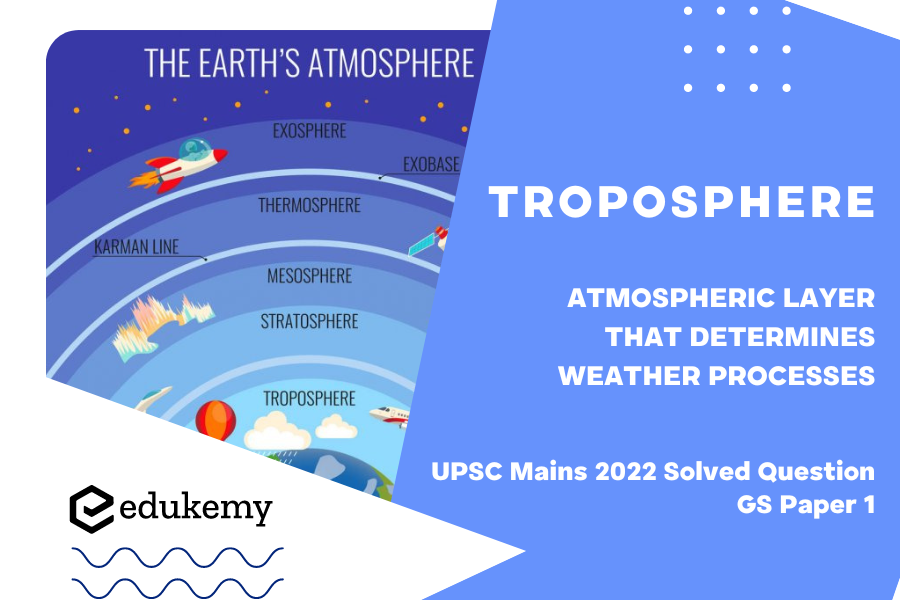The troposphere, the lowest layer of Earth’s atmosphere, plays a pivotal role in shaping weather processes and conditions. Extending from the surface up to an average altitude of about 8 to 15 kilometers, the troposphere contains the air we breathe and is where nearly all weather events occur. Its significance lies in its dynamic characteristics, as it is constantly in motion due to the uneven heating of Earth’s surface by the sun. As sunlight warms the Earth, the troposphere responds with vertical and horizontal air movements, creating weather patterns such as wind, storms, and precipitation. Temperature decreases with altitude in the troposphere, which leads to the formation of clouds and the occurrence of various weather phenomena. Additionally, the troposphere houses water vapor, a key component for the development of clouds and precipitation. The interactions within this atmospheric layer are crucial for the regulation and manifestation of weather, making the troposphere a fundamental determinant of the Earth’s climate and meteorological processes. Understanding the dynamics of the troposphere is essential for predicting and comprehending weather patterns, enabling us to better prepare for and respond to the ever-changing atmospheric conditions that impact our daily lives.
UPSC Mains General Studies Paper – 1 Mains 2022
Factors responsible for the location of primary, secondary, and tertiary sector industries in various parts of the world including India.
UPSC Mains Civil Services IAS Exam Question Paper – 2022
Approach:
- Start with explaining the keyword ‘troposphere’ concerning the atmosphere.
- Discuss the specifications of the troposphere.
- Explain the Significance of the Troposphere in the Determination of Weather Phenomena.
- Conclusion/way forward accordingly.
Introduction:
- The troposphere is the layer closest to the Earth’s surface, and it contains most of the atmospheric mass. This layer is composed mainly of nitrogen and oxygen, with small amounts of other gases, such as carbon dioxide and water vapor. The troposphere also contains dust, smoke, and other particulate matter. Most of the mass (about 75-80%) of the atmosphere is in the troposphere and is where most weather phenomena occur. Weather refers to short-lived temperature, wind, and precipitation conditions that vary from place to place.
Body:
Specifications of the troposphere:
- The troposphere extends upward to about 10 km above sea level.
- The height of the troposphere varies with latitude because the temperature decreases with altitude, and this temperature gradient is more pronounced at the poles than at the equator.
- This layer is also where most of the Earth’s weather occurs, as it contains the majority of the Earth’s water vapor and is the site of the majority of cloud formation and precipitation.
- The troposphere contains 99% of the total mass of water vapour and aerosols in the atmosphere.
Significance of Troposphere in Determination of Weather Phenomena:
- Water vapor is primarily concentrated in the troposphere, with trace amounts in the poles and 4 percent or more in the tropic regions. The concentration of water vapor in the troposphere varies depending on temperature and location, with higher concentrations found in warm and humid regions. As the sun heats the Earth’s surface, water evaporates and rises into the atmosphere, where it forms clouds and eventually falls back to the surface as precipitation. This process is known as the water cycle and is a key driver of weather patterns in the troposphere.
- The decrease in temperature with increasing altitude is known as the lapse rate. On average, the temperature in the troposphere decreases by about 6.5 degrees Celsius per kilometer of altitude. This lapse rate varies depending on the location and weather conditions. Water vapour is also a greenhouse gas that absorbs and re-emits thermal radiation, contributing to the warming of the troposphere. The amount of water vapour in the troposphere plays a crucial role in regulating the Earth’s temperature and climate.
- The uneven heating of the Earth’s surface causes the air in the troposphere to rise and fall in convection currents, leading to the formation of high and low-pressure systems. This movement of air creates the wind patterns we see around the world. The circulation of air and the movement of weather systems are important for regulating the Earth’s climate.
- The water cycle, also known as the hydrological cycle, is the continuous process by which water evaporates from the surface of the Earth, rises into the atmosphere, forms clouds, and falls back to the surface as precipitation. This precipitation can take many forms, including rain, sleet, snow, and freezing rain, depending on the temperature and other conditions within the atmosphere.
- Smog is a form of air pollution that can occur in the troposphere. It is typically formed from a mixture of pollutants, such as nitrogen oxides and volatile organic compounds, that react in the presence of sunlight to form ground-level ozone and fine particulate matter. This can lead to several health and environmental problems, including respiratory issues, reduced visibility, and damage to crops and ecosystems.
Conclusion:
Hence, the troposphere is a vital layer of the Earth’s atmosphere that plays a crucial role in determining the Earth’s weather and climate. It is the layer that is most affected by human activities and is also the layer that is most affected by the Earth’s changing climate. Understanding the processes that occur in the troposphere is essential for understanding and predicting the Earth’s weather and climate.
Frequently Asked Questions (FAQs)
Q: Why is the troposphere considered a significant atmospheric layer in determining weather processes?
A: The troposphere is crucial in determining weather processes because it is the lowest layer of Earth’s atmosphere where weather events occur. This layer extends from the Earth’s surface up to an average altitude of about 8 to 15 kilometers (5 to 9 miles). The proximity to the Earth’s surface allows the troposphere to directly interact with the underlying land, water, and vegetation, influencing temperature, humidity, and pressure. Weather phenomena, such as clouds, precipitation, and storms, are predominantly associated with the dynamic processes within the troposphere.
Q: How does the vertical structure of the troposphere impact weather patterns?
A: The vertical structure of the troposphere plays a crucial role in shaping weather patterns. Temperature decreases with altitude in the troposphere, creating a stratified layer where warmer air is near the Earth’s surface, and cooler air is found at higher altitudes. This temperature gradient contributes to the development of convection currents and the vertical movement of air masses. Rising warm air creates areas of low pressure, leading to cloud formation, condensation, and ultimately precipitation. Understanding these vertical processes within the troposphere is essential for predicting and understanding various weather phenomena.
Q: What role does the troposphere play in the greenhouse effect and climate regulation?
A: The troposphere is a key player in the Earth’s climate regulation due to its involvement in the greenhouse effect. Greenhouse gases, such as water vapor, carbon dioxide, methane, and others, are concentrated in the troposphere. These gases trap heat from the Sun and prevent it from escaping back into space, creating a warming effect. The regulation of temperature within the troposphere is vital for maintaining the Earth’s climate. Changes in greenhouse gas concentrations can lead to alterations in temperature and weather patterns, contributing to long-term climate trends. Therefore, understanding the troposphere’s composition and dynamics is crucial for comprehending the broader implications on global climate systems.
In case you still have your doubts, contact us on 9811333901.
For UPSC Prelims Resources, Click here
For Daily Updates and Study Material:
Join our Telegram Channel – Edukemy for IAS
- 1. Learn through Videos – here
- 2. Be Exam Ready by Practicing Daily MCQs – here
- 3. Daily Newsletter – Get all your Current Affairs Covered – here
- 4. Mains Answer Writing Practice – here
Visit our YouTube Channel – here



